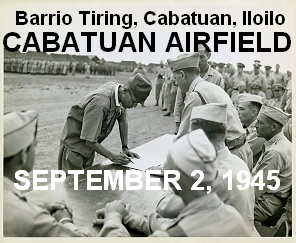
Col. Tozuka signs the surrender instrument
as Col. Stanton looks on, in Cabatuan Airfield,
Barrio Tiring, Cabatuan, Iloilo,
September 2, 1945,
Panay Island, Philippines
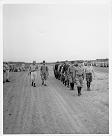
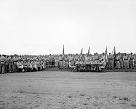
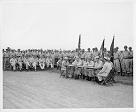
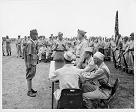
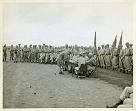
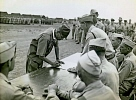
More about Lt. Kumai
A Soldier's Responsibility (Photos)
Kumai's Story (www.kumaibuki.com)
Chapters of Blood and Mud in the Philippines mentioning "Cabatuan Airfield":
Chapter 7,
Chapter 8,
Chapter 10,
Chapter 11
The Blood and Mud in Philippines, Anti-guerilla Warfare on Panay Island;
Toshimi Kumai, author;
Yukako Ibuki, translator;
Ma. Luisa Mabunay, editor;
Ricardo T. Jose, editor
|
Who's the American Major-General that Lt. Toshimi Kumai saw?
WAS REAR ADMIRAL RALPH O. DAVIS MISTAKEN FOR
MAJ. GENERAL RAPP BRUSH BY LT. KUMAI?
© RMC / , 2016
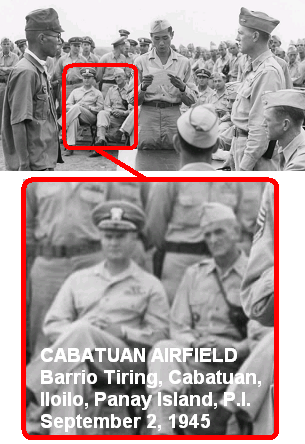
Rear Admiral Davis & Brig. General Myers
during the Japanese surrender signing ceremony
at Cabatuan Airfield,
Barrio Tiring, Cabatuan, Iloilo, Panay Island,
Philippines, September 2, 1945
|
|
June 10, 2016
Japan surrendered on August 15, 1945. To disseminate this news to the 1,800 Japanese soldiers in Panay, liaison planes dropped information phamplets throughout the island stipulating that surrender panels be displayed by all units.
On August 24 or 25, 1945, an American observation plane, which appeared to be looking for the Japanese, flew over Bucari, Leon. The Japanese unit in Bukari reacted by spreading a signalling panel, and then tried to send signals to the plane.
"Recognizing the signalling panel, the plane's body swung left and right and dropped a communications tube. Inside were instructions of the date and place where a representative of the Japanese Army was to proceed" - Lt. Kumai (The Blood and Mud in the Philippines: Anti-Guerilla Warfare in Panay Island)
On August 28 (according to the Americans), the Japanese representatives came down from Bocari to Daja Dam Site, Maasin. They were then transported to the plaza of Maasin.
The manner of surrendering was discussed, and the resulting agreement was typed by T/4 Robert A. Way, secretary to the commanding officer of the 160th U.S. Infantry.
It was then signed by Colonel Raymond G. Stanton (commanding officer of the 160th Infantry Regiment) for the Americans, and Captain Kaneyoki Koike (the Kempei Tai commander in Panay) for the Japanese.
"Just when the signing was finished, it suddenly became calm. With the command, ‘Ten hut!’ Colonel Stanton and the others all stood up and saluted. As we turned together and saluted, we saw a noble Major General of around 50 years of age, who had a face like a young boy, followed by his staff. He was smiling contentedly and repeatedly returned our salute. A Japanese-American interpreter standing close to me whispered it was the 40th Division Commander, Major General Rapp Brush." - Lt. Kumai (The Blood and Mud in the Philippines: Anti-Guerilla Warfare in Panay Island)
- o -
There's just one problem with the last part, regarding the presence of Maj. Gen. Brush.
Two problems actually.
First, Maj. Gen. Rapp Brush was replaced by Brig. Gen. Donald Myers the month before, in July, 1945, as the commanding officer of the 40th Infantry Division. So Brush couldn't have been there any longer, especially in late August.
Secondly, from his file photo, Maj. Gen. Rapp Brush didn't appear to be young-looking as Lieut. Kumai would describe him to be.
So who was the American major-general that Lieut. Kumai saw?
Myers was only a one-star brig. general, not a two-star major general. And he looked old too anyway. So it couldn't have been Myers.
Brig. Gen. Robert O. Shoe, the assistant commander of the 40th Infantry Division, was likewise only a one-star officer.
If there was a two-star American officer who could be young looking, that would be Rear Admiral Ralph O. Davis.
But Davis' ship, the USS Estes, did not arrive in Iloilo until the afternoon of September 1, 1945. Which means that Davis too couldn't have been in Maasin the previous month.
So, again, who was the American major-general that Lieut. Kumai saw?
Perhaps the answer to this puzzle lies not in the surrender negotiations in Maasin but in the surrender signing ceremony in Cabatuan Airfield on September 2 when Col. Tozuka signed the surrender instrument.
Photos show that while Col. Ryoichi Tozuka was signing the surrender instrument in Cabatuan Airfield on September 2, 1945, both Brig. Gen. Myers and Rear Admiral Davis were in the background, sitting on the leftmost chairs, with the other officers to the right.
Did the sudden appearance of a two-star officer actually happen in Cabatuan and not in Maasin?
If so, then this would have been the probable sequence:
After the surrender instrument was signed by Col. Tozuka, Myers and Davis stood up, resulting in the "ten-hut."
And then, the Japanese-American interpreter Moffet Mitsuo Ishikawa (also in the photos) could have referred to Brig. Gen. Myers as the commanding officer of the 40th Infantry Division.
Since Kumai was in the mountains until the day before, he may not have known that Maj. Gen. Rapp Brush was already replaced by Brig. Gen. Donald Myers. And seeing a two-star insignia on Rear Admiral Ralph O. Davis, Kumai may have assumed Davis to be Brush.
A highly probable scenario actually considering that Davis had a young-looking face, and a two-star to boot.
- o -
The airfield was called Cabatuan Airfield by the Japanese Imperial Army, after the Municipality of Cabatuan, Iloilo where it was located; Tiring Landing Field by the Panay guerillas of Col. Macario Peralta and the Free Panay Government of Iloilo Governor Thomas Confesor, after Barrio Tiring, Cabatuan, where it was specifically located; Tiring Airfield and Tiring Field by the Americans, after Barrio Tiring, Cabatuan; and erroneously as Santa Barbara Airfield or Santa Barbara Airport by the Americans, erroneous since the airfield was not located in the neighboring town.
The Japanese forces operated Cabatuan Airfield the longest, from the time they arrived in Panay in 1942, until they retreated to the mountains in 1945.
CABATUAN AIRPORT
Cabatuan.com
Email:
(Bookmark this page for future reference)
|
|







